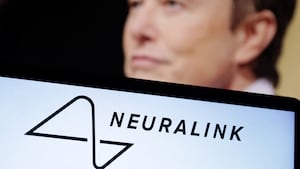You don’t need to drill a hole in your head and implant a microchip in order to lose weight. There are much safer ways of slimming down—including a new class of very promising drugs that make weight-control brain-computer interfaces (BCIs) seem downright perilous in comparison.
Conspiracy-peddling billionaire Elon Musk raised the prospect of computer-chip-aided weight-loss back in April, while discussing his Neuralink BCI in a TED interview. “I think you can solve a very wide range of brain injuries,” Musk said, “including severe depression, morbid obesity, sleep [disorders and] restoring memory in older people.”
It’s not an outlandish claim. Neuralink, like other experimental BCIs, rewires the nervous system. People suffering from paralysis have used the implants to regain partial control of their limbs. BCIs can even translate neural impulses—thoughts, basically—into radio signals and transmit them to drones, computers, or other devices.
So it’s not inconceivable that someone suffering from morbid obesity could use a BCI to bypass the parts of their brain that urge them to overeat. But there are problems. For starters, while there are BCIs that people can wear like hats, the most versatile and sensitive ones—like Neuralink’s—require brain surgery. Surgeons literally drill a hole in the patient’s skull and implant the device.
It’s invasive and risky under the best of circumstances. Implanted BCIs “pose surgical risks, such as infection and rejection,” according to the U.S. Government Accountability Office.
There might be reasons to be especially concerned about Neuralink. Federal authorities opened an investigation into the California-based company last year after employees complained of rushed testing that inflicted unnecessary harm on animal test subjects. Despite this, in September an independent review board gave Neuralink the go-ahead to recruit human test subjects for a lengthy series of trials.
In any event, there are medical interventions for morbid obesity that are likely much safer than any experimental brain device could ever be. Most notably, a new class of drugs called “glucagon-like peptide 1 agonists,” or GLP-1s. It might be more popularly known by its commercial analog Ozempic.
Originally used for treating diabetes, GLP-1s also helps curb hunger. Scientists aren’t totally sure how they work, but the Mayo Clinic in Minnesota pointed out that the drugs “slow the movement of food from the stomach into the small intestine. As a result, you may feel full faster and longer, so you eat less.”
The U.S. Food and Drug Administration approved the first GLP-1 solely for the treatment of obesity, Eli Lilly’s Zepbound, last month. After large-scale trials, the FDA concluded the injected drug was safe and effective—but stressed that it worked best when taken in conjunction with a reduced-calorie diet and an increase in physical activity.
The best part? No brain surgery.
When it comes to controlling hunger, both implants and drugs seem to come with an obvious potential for abuse. Imagine someone with an eating disorder gaining, by way of a drug or brain implant, total control of their hunger impulses.
But Tracy Richmond, a doctor who treats eating disorders at Boston Children’s Hospital, downplayed that risk. Clinicians are pretty skilled at identifying eating disorders and withholding any intervention—surgical or otherwise—that might exacerbate the conditions, she told The Daily Beast. “Most of the time, people could be screened out if they have an eating disorder.”
If anything, a hunger-controlling drug or brain implant risks causing an eating disorder. Richmond cited an historical precedent: the Minnesota Starvation Experiment in 1944 and 1945. In that government-assisted experiment, University of Minnesota researchers restricted the diets of 36 volunteers for six months before adding back calories—essentially starving them in order to understand the effects of famine and post-famine conditions.
The researchers were shocked to find that many of the test subjects developed anorexia in the aftermath of prolonged starvation, and voluntarily restricted their caloric intake even when food was abundant. “When many people are underfed relative to where their body wants to be, their thoughts go to more obsessional thoughts,” Richmond said, meaning starving people sometimes become obsessed… with starving.
Few medical interventions are totally risk-free—but some are much riskier than others. When it comes to weight-loss, it’s obvious which intervention—a GLP-1 or a brain implant—is safer. “The molecular approach is an effective way to target the hunger systems fairly specifically and with far less risk than an implant,” Samuel Hires, a University of Southern California neurobiologist, told The Daily Beast.
BCIs are a promising technology. But it doesn’t change the fact that BCI experiments have mostly involved human subjects with serious conditions for which there are no other treatments such as paralysis, for example.
Before you drill a hole in your head and implant a device for treating some condition, you might want to exhaust all other options first. That might mean trying a drug like GLP-1, or good old fashioned diet, exercise, and discipline.
And besides, given the promise of safe and effective GLP-1 drugs, the FDA might never approve a brain-chip for weight-loss. “I don’t see a realistic path to market for invasive BCI for obesity now that GLP-1 agonists have rolled out,” Hires said.









